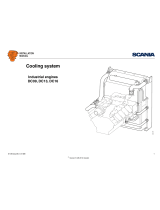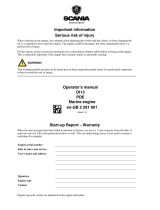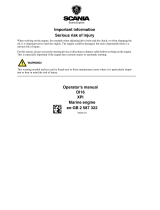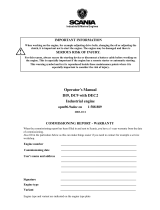
01:01 Issue 8.0 en-GB
© Scania CV AB 2016, Sweden
Installation manual
Engine
Industrial engines
DC09, DC13, DC16
OC16
333 291

INSTALLATION
MANUAL
© Scania CV AB 2016, Sweden
01:01 Issue 8.0 en-GB 2
Engine suspension....................................................................................................3
Design requirements............................................................................................ 3
Flexible engine suspension.................................................................................. 4
Rigid engine suspension...................................................................................... 5
Permissible installation and operating angles ..................................................... 6
Flywheel housings............................................................................................... 7
Generator set dynamics ....................................................................................... 8
Lifting the engine ................................................................................................ 8
Accessibility for maintenance and repairs ............................................................9
Installation requirements ..................................................................................... 9
Clearances ......................................................................................................... 11
Engine alignment...................................................................................................12
Flexible coupling............................................................................................... 12
Aligning engine and shafts................................................................................ 13
Power transmission ...............................................................................................18
Flexible coupling............................................................................................... 18
Friction clutch ................................................................................................... 18
Transmission types ................................................................................................20
Mechanical transmissions ................................................................................. 20
Belt transmissions ............................................................................................. 20
Power take-offs ......................................................................................................22
Front-mounted power take-offs......................................................................... 22
Side-mounted power take-offs .......................................................................... 25
Air compressor ......................................................................................................31
Torsional oscillations.............................................................................................32
Data for torsional oscillation calculation .......................................................... 33
Torsional oscillation calculations from Scania................................................. 34
General tightening torques for screw joints ....................................................... 35
Specification of normal tightening torques....................................................... 35
Tightening torques ............................................................................................ 36
Sticker “Powered by Scania”............................................................................... 39

INSTALLATION
MANUAL
© Scania CV AB 2016, Sweden
Engine suspension
01:01 Issue 8.0 en-GB 3
Engine suspension
Design requirements
The type of engine suspension that is appropriate varies for different engine installa-
tions. In general, the following applies:
• The engine suspension should be designed for the forces it is exposed to, both
continuously and momentarily during operation. Such forces are reaction forces
from the transmitted torque and in some cases longitudinal acceleration, retarda-
tion and reaction forces in the engine.
• Both the engine suspension and the engine bed should be designed so that there
are no resonant oscillations within the engine speed range. They should also be
designed so that annoying vibrations from the engine are not transmitted to the
surroundings.
• The engine bed location and the engine suspension must be designed so that the
permissible angles of inclination for the engine are not exceeded. See the table in
the Permissible installation and operating angles
section.
• The engine suspension and engine bed should be designed in a way which allows
access for maintenance and repairs.
IMPORTANT!
If the angles of inclination are exceeded, lubrication system performance will deteri-
orate, which can cause damage to the engine or reduce its service life.
There are two standard engine suspension designs:
• flexible engine suspension
• rigid engine suspension.

INSTALLATION
MANUAL
© Scania CV AB 2016, Sweden
Engine suspension
01:01 Issue 8.0 en-GB 4
Flexible engine suspension
Flexible engine suspension dampens vibrations more effectively than rigid engine
suspension. Flexible engine suspension does not require such careful alignment of
the engine as rigid engine suspension. However, flexible engine suspension does not
absorb longitudinal and lateral forces in the engine to the same extent as rigid engine
suspension.
Insulators
Cushyfloat insulators with hardness 55 or 65 Shore are delivered as standard.
Tightening torque. Hardness marking.
The engine bracket and frame or engine bed should be
parallel.
The vertical centre lines should coincide laterally. The upper and lower parts of the insulators should be
parallel longitudinally.
334 280
Examples of flexible engine suspension.
310 404
160±10 Nm
310 405
55
55
alt. 65
310 407
max 1°
310 408
0°
310 406
0°
55

INSTALLATION
MANUAL
© Scania CV AB 2016, Sweden
Engine suspension
01:01 Issue 8.0 en-GB 5
Rigid engine suspension
A rigid engine suspension can absorb greater forces in all directions than flexible en-
gine suspension. It requires highly accurate alignment of the engine in relation to the
driven unit. On the other hand, it requires no special flexibility in the hoses, pipes and
controls connected to the engine.
A rigid engine suspension can be used in engine installations where vibration causes
no significant problems and where other characteristics make it desirable.
Even with a rigid engine suspension, the transmission of vibration to the engine bed
can be kept low if the masses of the engine bed and connected parts are large in re-
lation to the mass of the engine.
It is also possible to construct flexible engine suspension between the frame and the
engine bed to reduce the transmission of vibration to the engine bed.
344 281
Examples of rigid engine suspension.

INSTALLATION
MANUAL
© Scania CV AB 2016, Sweden
Engine suspension
01:01 Issue 8.0 en-GB 6
Permissible installation and operating angles
Maximum installation angle means maximum permissible installation angle for an
engine relative to the horizontal plane. The angle indicates the limit for engine incli-
nation during continuous operation.
Maximum operating angle means maximum permissible angle of inclination for an
engine in operation and with minimum oil level. The angle may only be used for
short periods. The given maximum forward or rearward operating angles are not ap-
plicable to their full extent if the engine is inclined laterally at the same time.
Engine type Type of oil sump Max. installation angle Max. operating angle Oil capacity (litres)
Inclination rear-
wards and for-
wards
Inclination lat-
erally
Inclination rear-
wards and for-
wards
Inclination lat-
erally
Min. Max.
DC09 Deep front without ladder frame 12° 12° 30° 30° 31 36
DC09 Low 12° 12° 25° 30° 28 35
DC13 Deep front without ladder frame 12° 12° 30° 30° 30 36
DC13 Deep front with ladder frame 12° 12° 30° 30° 39 45
DC13 Low 12° 12° 25° 30° 28 34
DC13 With deep centre part 12° 12° 35° 45° 33 39
DC16, OC16 Deep front without ladder frame 12° 10° 25° 30° 40 48
DC16 Low 12° 10° 25° 30° 29 37

INSTALLATION
MANUAL
© Scania CV AB 2016, Sweden
Engine suspension
01:01 Issue 8.0 en-GB 7
Flywheel housings
Silumin housings are supplied as standard on all industrial engines. The maximum
permissible bending torque for a silumin housing is 10,000 Nm. This presumes that
there are no axial loads from, for example, the propeller shaft, abnormal G forces or
vibration.
For certain engine types, it is also possible to select a nodular iron flywheel housing.
Nodular iron housings can dampen vibrations at certain engine speeds but increase
vibrations at other engine speeds. Nodular iron is stronger than silumin and can there-
fore tolerate greater bending and torsional forces.
The stronger nodular iron housings are recommended in installations where transport
causes serious stress on the flywheel housing, such as in dumper type trucks and gen-
erator sets with high outputs.
If it is difficult to determine the size and nature of the load, contact your nearest Sca-
nia distributor.

INSTALLATION
MANUAL
© Scania CV AB 2016, Sweden
Engine suspension
01:01 Issue 8.0 en-GB 8
Generator set dynamics
If vibration levels in a generator set are too high, it could be due to resonance. This
may be because resonant frequencies of the receiving system are the same as the fre-
quency of the torque and disrupting power pulses that arise during normal operation
of combustion engines with a crankshaft. The resonant frequencies of the system de-
pend in turn on the mass and rigidity of component parts.
It is the responsibility of the installer to check that no resonant frequencies or vibra-
tion levels that could damage component parts are found anywhere in the engine in-
stallation.
The measurement and evaluation of vibrations in static parts is described in interna-
tional standards. See ISO 8528-9.
Lifting the engine
WARNING!
The engine lifting eyes are dimensioned for lifting the engine only, not the engine to-
gether with connected equipment or frame!
5
4
3
2
1
6
6
344 282
Example of generator set.
1. Engine.
2. Flywheel housing.
3. Adapter.
4. Generator.
5. Engine bed.
6. Vibration insulators.

INSTALLATION
MANUAL
© Scania CV AB 2016, Sweden
Accessibility for maintenance and repairs
01:01 Issue 8.0 en-GB 9
Accessibility for maintenance and repairs
Installation requirements
The installer is responsible for ensuring accessibility for maintenance and repairs.
Note:
There must be sufficient space at installation so that standard times for maintenance
and repairs can be attained.
The following requirements for accessibility must be met:
• Canopies and connected components must be designed so that the engine can be
removed and fitted relatively easily.
• In the case of static engine installations, there should be permanent securing
points for lifting devices above the unit.
• The fuel system must be easily accessible for maintenance and bleeding.
• It should be possible to read the graduations on the flywheel when adjusting
valves and unit injectors.
• It should be possible to remove and fit the cylinder head, rocker covers and push-
rods while leaving the engine in place.
• It must be possible to remove the oil sump in order to renew cylinder liners or pis-
tons with the engine in place.

INSTALLATION
MANUAL
© Scania CV AB 2016, Sweden
Accessibility for maintenance and repairs
01:01 Issue 8.0 en-GB 10
• It should be easy to fill and drain oil. In addition, the oil dipstick must be easily
accessible.
• Centrifugal oil cleaners and oil filters must be easy to access for maintenance and
for renewal.
• It should be easy to fill and drain coolant.
• Engine air filters must be located so that they are easy to access for the renewal
of filter elements.
It must also be easy to carry out maintenance on the following components:
• Turbocharger
• Starter motor
• Alternator
• Coolant pump
• Radiator
• Cooling fan
• Clutch
• Batteries
• Crankcase ventilation filter
For gas engines, it must also be easy to carry out maintenance on the following com-
ponents:
• Spark plug
•Flame arrestor
• Gas mixer insert
• Electric throttles
• Gas regulator
• Lambda sensor

INSTALLATION
MANUAL
© Scania CV AB 2016, Sweden
Accessibility for maintenance and repairs
01:01 Issue 8.0 en-GB 11
Clearances
The most important clearances are shown in the table and illustrations. The specified
measurements apply to the largest standard equipment.
Meas
ure-
ment
Clearance in mm For maintenance or renewal of
DC09 DC13 DC16 OC16
A 150 150 150 380 cylinder liner, cylinder head, etc.
B 250 260 260 260 oil sump
1
1. If the oil sump has a special design, these values do not apply.
F 400 400 400 500 various units
F
B
F
A
F
344 285
Clearances for DC09 and DC13.
F
A
A
B
F
F
F
344 286
Clearances for DC16 and OC16.

INSTALLATION
MANUAL
© Scania CV AB 2016, Sweden
Engine alignment
01:01 Issue 8.0 en-GB 12
Engine alignment
The alignment of the engine in relation to the driven unit is very important in order
to prevent malfunctions. Otherwise there is a risk of vibration and serious stress to
the crankshaft, engine brackets, drive shaft and coupling, causing damage which is
costly to repair.
Alignment should be checked regularly on certain vibration-sensitive engine instal-
lations. Adjust engine alignment with shims between the engine bed and the engine
suspension.
Flexible coupling
The alignment requirements are reduced if a flexible coupling is installed between
the engine and the driven unit. Refer to the data on the flexible coupling concerned
for permissible deviations.
Flexible coupling allows a certain angular displacement towards the output shaft. It
also has an effect of evening out irregularities in torque and therefore counteracts the
tendency towards torsional oscillation. The correct choice of rubber hardness reduces
the stress on the driven units.
Relatively large deviations are permissible with flexible couplings. However, align-
ment should be as accurate as possible to achieve low vibration and a long service
life on the coupling.

INSTALLATION
MANUAL
© Scania CV AB 2016, Sweden
Engine alignment
01:01 Issue 8.0 en-GB 13
Aligning engine and shafts
Start from the driven shaft when aligning. First check that this is straight. Alignment
is made easier if the engine brackets are equipped with adjusting screws for vertical
and lateral adjustment. However, permanent setting should be made using shims.
Adjust the engine alignment vertically using shims between the engine bed and en-
gine suspension and laterally by moving the engine sideways on the surface. Shafts
with flanges: Start by aligning roughly and secure the engine to its engine bed. Mate
the flanges (1) so that the guide edge of one flange enters the guide hole of the other
flange.
Calculation of angular deviation
1. Fit the stand for the dial gauge (2) to the driving flange.
2. Align the tip of the dial gauge with the axial surface of the other flange as far as
possible.
3. Zero the dial gauge at 12:00
4. Place one of the retaining screws through both flanges without tightening it.
5. Turn the shafts at the same time and read the dial gauge at intervals of 90° while
turning one revolution. Enter the values in the table. Make sure you use the right
signs.
6. Calculate the angular deviation between the shafts using the values.
Location of measurement point Measurement value
1
1. + means inwards and - means outwards
12:00 ±0 mm
3:00 ± mm
6:00 ± mm
9:00 ± mm
2
1
344 283
Measuring angular deviation.

INSTALLATION
MANUAL
© Scania CV AB 2016, Sweden
Engine alignment
01:01 Issue 8.0 en-GB 14
Calculating thickness of required shims
Note:
Make sure you use the right signs in the calculations.
• If t is positive, shims should be added to the front or removed from the rear.
• If t is negative, shims should be added to the rear or removed from the front.
t = thickness of required shims.
L = distance between engine suspensions.
D = diameter of the flange where the dial gauge is mounted.
t =
6 x L
D

INSTALLATION
MANUAL
© Scania CV AB 2016, Sweden
Engine alignment
01:01 Issue 8.0 en-GB 15
Calculating lateral adjustment
Note:
Make sure you use the right signs in the calculations.
• If s is positive, the front engine suspension must be moved to the right.
• If s is negative, the front engine suspension must be moved to the left.
Checking parallelism of the flanges with a feeler gauge
Angular deviation between the shaft centrelines can also be checked using a 0.1 mm
feeler gauge. Do this by measuring the distance between the surfaces of the flanges
at the outer edges.
During measurement, the engine must be tightened onto the engine bed.
s = lateral displacement of engine suspension.
L = distance between engine suspensions.
D = diameter of the flange where the dial gauge is mounted.
s =
(3 o'clock - 9
o'clock) x L
D
344 284

INSTALLATION
MANUAL
© Scania CV AB 2016, Sweden
Engine alignment
01:01 Issue 8.0 en-GB 16
Measuring parallel displacement
1. Move the tip of the dial gauge to the radial surface of the flange. Pull apart the
flanges (1) so that the guide edge is released as depicted in the figure to the right.
2. Zero the dial gauge (2) at 12:00
3. Lift or press down the driven shaft as far as the radial clearance will allow. Read
the dial gauge and enter the reading with the correct sign on the radial clearance
line.
If the driven shaft is very long, there must also be compensation for bending of
the shaft from its own weight. This can be obtained by lifting the end of the shaft
using a spring balance, which then shows the weight of the flange and half the
free part of the shaft. Deflection can then be calculated using this weight.
The same must also be done if the drive shaft is long or has some play.
4. Zero the dial gauge again. Place one of the retaining screws through both flanges
without tightening it.
5. Turn the shafts at the same time, read the dial gauge at intervals of 90° while turn-
ing one revolution and enter the values in the table. Make sure you use the right
signs.
6. Calculate the parallel displacement between the shafts using these values.
Location of measure-
ment point
Measurement value
1
1. + means inwards and - means outwards
12:00 ±0 mm
3:00 ± mm
6:00 ± mm
9:00 ± mm
Radial clearance
2
2. + means lift and - means press
±mm
2
1
344 287
Measuring centring.

INSTALLATION
MANUAL
© Scania CV AB 2016, Sweden
Engine alignment
01:01 Issue 8.0 en-GB 17
Calculating parallel displacement
Note:
Make sure you use the right signs.
Shafts without flange
If both shaft ends are free during alignment, alignment can be checked using a dial
gauge (2) set up as depicted in the figure. Readings should be taken with the tip of
the dial gauge in two different places at least 200 mm apart axially. Turn the shafts
at the same time and read the results on the dial gauge.
Permissible deviations
After taking measurements, a final check should be made. All screws, except those
for the flange joint, should be tightened to the torque specified by the manufacturer.
Upon measurement, deviation should not exceed 0.1 mm.
The requirements for the accuracy of the alignment can vary depending on the design
of the engine installation. If the requirements for accuracy are lower, the permissible
deviation may be greater than indicated above.
Vertical Lateral
t =
6 o'clock + clear-
ance
t =
3 o'clock + 9
o'clock
22
2
344 288
Measuring with free shaft ends.

INSTALLATION
MANUAL
© Scania CV AB 2016, Sweden
Power transmission
01:01 Issue 8.0 en-GB 18
Power transmission
Engine torque is normally transmitted to the driven unit in one of the following ways:
• Through a flexible coupling which cannot be disengaged, e.g. engines for gener-
ator sets.
• Through a friction coupling, possibly also used together with a flexible coupling,
and via a reduction gear, torque converter or belt transmission.
Flexible coupling
Many engine installations require a flexible coupling between the engine and the
driven unit to dampen irregularities in the system. Information about suitable flexible
couplings can be obtained from your nearest Scania distributor or from the coupling
supplier.
Carry out a torsional oscillation calculation before selecting a flexible coupling.
When a flexible coupling is recommended based on the torsional oscillation calcula-
tion, it is important that the installed coupling and other transmission equipment fol-
low the precise specification of the calculation.
For operation with generator set, there must be no play in the flexible coupling be-
tween the engine and generator.
Note:
For gas engines in generator operation, a single-bearing generator with a friction
clutch should be installed so that the engine control unit is capable of detecting mis-
firing. If a flexible coupling is required in the installation, misfire detection must be
deactivated in SDP3.
Friction clutch
Industrial installations use two types of friction clutches, a vehicle clutch and an in-
dustrial clutch. The industrial clutch has a greater capacity, i.e. it can transfer greater

INSTALLATION
MANUAL
© Scania CV AB 2016, Sweden
Power transmission
01:01 Issue 8.0 en-GB 19
torque than the vehicle clutch. There are many different makes of industrial clutches
on the market. It is important that the industrial clutch is not subjected to loads that
could cause overloading of the clutch bearings. Vehicle clutches are used together
with conventional multi-ratio gearboxes, where the transmission can be disengaged.
Single-bearing clutches may not be subjected to large lateral forces and are therefore
most often used in engine installations where torque is transmitted straight to the rear
via a propeller shaft or similar power transmission. For heavier operation where large
lateral forces arise, such as belt transmissions, Scania recommends using clutches
which absorb lateral forces in the main bearings. This type of clutch does not have a
support bearing in the flywheel.
It is also important that a remote-controlled clutch has no remaining pressure on the
release bearing, neither when engaged nor disengaged, since the release bearing is
then subject to rapid wear. For this type of clutch operation, we recommend the use
of ball bearings as release bearings.
See the illustration in the Belt transmission in multi-engine installations
section for
how a belt transmission should be set up in a multi-engine installation.
If the engine installation has a clutch other than a friction type, e.g. hydrodynamic
(wet) clutch, the necessary installation instructions can be obtained from the clutch
supplier.
Note:
The crankshaft should not be subjected to axial pressure from the clutch. Check this
after fitting.

INSTALLATION
MANUAL
© Scania CV AB 2016, Sweden
Transmission types
01:01 Issue 8.0 en-GB 20
Transmission types
Mechanical transmissions
Mechanical transmissions are the most common type on single engine installations.
These may be multi-ratio gearboxes or reduction gears.
If an engine is supplied without a gear or gearbox, affected parts of the engine (fly-
wheel, flywheel housings etc.) can still be adapted so that the gears and torque con-
verters available on the market can be fitted.
For certain gears and torque converters, there are requirements to ensure that the ax-
ial run-out and radial run-out are not too great. Therefore check at installation to en-
sure that the supplier's requirements are met.
Belt transmissions
Belt transmissions are appropriate in, for instance, multi-engine installations where
two or more engines drive a common output shaft. One of the advantages of a belt
transmission is that it is easy to adapt to the appropriate gear ratio.
The belt transmission functions to some extent as a flexible coupling, runs silently
and has a long service life. Apart from checking belt tension and alignment, belt
transmissions do not require any special maintenance.
There are belt transmissions with different types of belts, such as single V-belts and
devices consisting of two or more V-belts coupled together.
Which belt type to choose depends on several factors. More information and help in
dimensioning a belt transmission can be obtained from the belt manufacturer.
Large lateral forces may arise during belt operation. Accurate alignment and check-
ing of the belt tension are therefore necessary. A different belt tension results in in-
creased bearing load and displacement of the centre of the load. The lateral loading
can be reduced by e.g. changing the size of the pulley.
Page is loading ...
Page is loading ...
Page is loading ...
Page is loading ...
Page is loading ...
Page is loading ...
Page is loading ...
Page is loading ...
Page is loading ...
Page is loading ...
Page is loading ...
Page is loading ...
Page is loading ...
Page is loading ...
Page is loading ...
Page is loading ...
Page is loading ...
Page is loading ...
Page is loading ...
/










